We are getting to the busy end of the NWSL Challenge Cup. The quarterfinals came this past weekend and with them some very interesting matchups to be seen. One of these was a rematch of the opening game of the whole tournament in the match between the North Carolina Courage and the Portland Thorns. The top-ranked seed entering the play-off bracket against the bottom-ranked seed seemed to suggest another victory for North Carolina would be the outcome. However, Portland, who lost all four of their matches in the build-up to this one, pulled off the upset of the tournament by beating the defending NWSL champions 1-0 on the day.
This tactical analysis will break down the key point from this tight contest this past Saturday. It will cover North Carolina’s attacking outlets through the channels, before breaking down the key points on both the offensive and defensive side of the game for Portland, and how they came out successful as they look to carry this momentum into the semi-finals midweek.
Lineups
North Carolina came into this match at full strength, setting up in their patented 4-2-2-2 formation, a system we have also seen signs of being used by Pep Guardiola for Manchester City in the Premier League, a tactic that might pay dividends come their Champions League push. Williams and Hamilton led the line with Debinha and Dunn pulling the strings right behind them. O’Sullivan and Mewis present the perfect double-pivot to offer the Courage a combination of offensive and defensive contribution. The defence remained unchanged with Hinkle and Merrick in the full-back positions and Abby Erceg partnering Abby Dahlkemper.
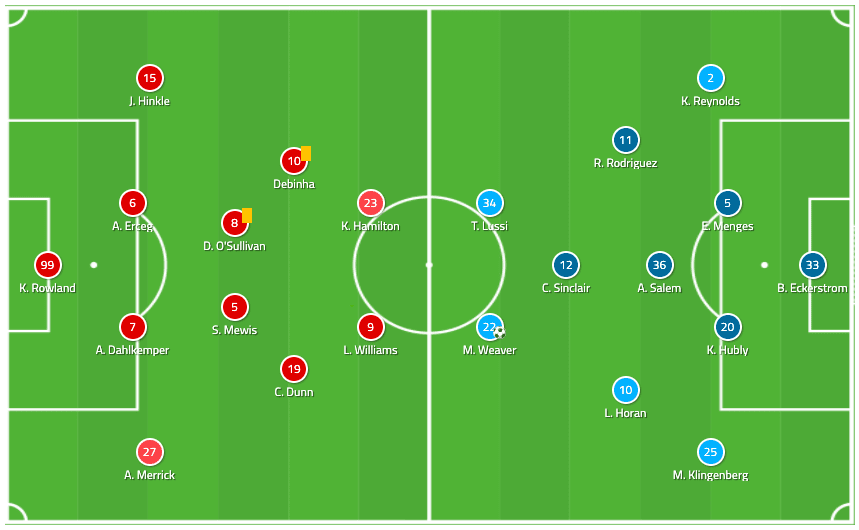
For Portland, the biggest change came in goal, with Eckerstrom covering due to injury. Weaver, the second-overall draft pick from this summer, partnered Lussi up top with Sinclair in behind. Horan and Rodriguez joined Salem in a midfield-three protecting the defence and restricting the area North Carolina’s attacking talent had to work with as we will go into later. In defence, Klingenberg and Reynolds looked to provide the side width in attack from full-back due to the narrow nature of the formation, while Hubly and Menges started in the centre of defence.
North Carolina’s attacking focus
As the dominant force in the NWSL, North Carolina set out as they meant to go on in this quarterfinal of the Challenge Cup. Within the first minute they had broken through Portland’s defence using tactics we would see consistently throughout the duration of the match.
Playing in their 4-2-2-2 formation, it is up to the strikers and advanced midfielders to provide width when necessary, specifically in moments of transitions. In this match, it was the strikers who moved into these areas. As North Carolina progressed up the pitch centrally, Lynn Williams and Kristen Hamilton moved away from their centre-back markers and into space behind the full-backs. Here, the midfielders looked to release their attackers down the channels. The advanced midfielders Debinha and Crystal Dunn would then join the second striker in providing options in and around the box for the player in possession as they approached the byline.
This was effective specifically in transition due to Portland’s structure. Playing in a 4-3-1-2, the eight-seed of the tournament relied on their full-backs to provide width as they looked to build attacks. While this was a crucial aspect of their system in possession, it left them vulnerable in numerous instances during this match. As soon as possession was won back, Williams and Hamilton drifted into this space in the channels vacated by the Portland full-backs and looked to receive a pass with time and space ahead of them to run into towards the Portland centre-backs.
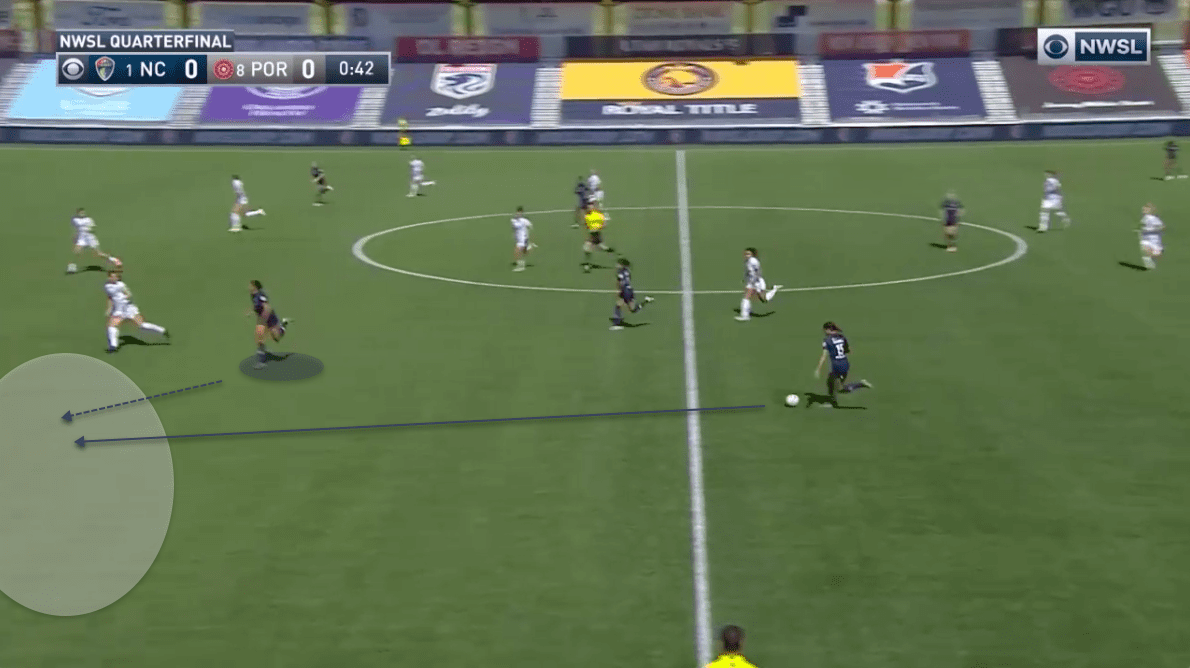
In the image above possession has been won by North Carolina in their defensive half. Acknowledging the opportunity to counter, the ball is moved from the right side of the pitch to the left where the side have more room to move into higher up the pitch. As Hinkle receives the pass she drives forward and waits for William to make her move. When in possession down their left side, Reynolds often tucked in centrally to provide defensive cover through this area of the pitch. This worked in favour of North Carolina’s tactics, however.
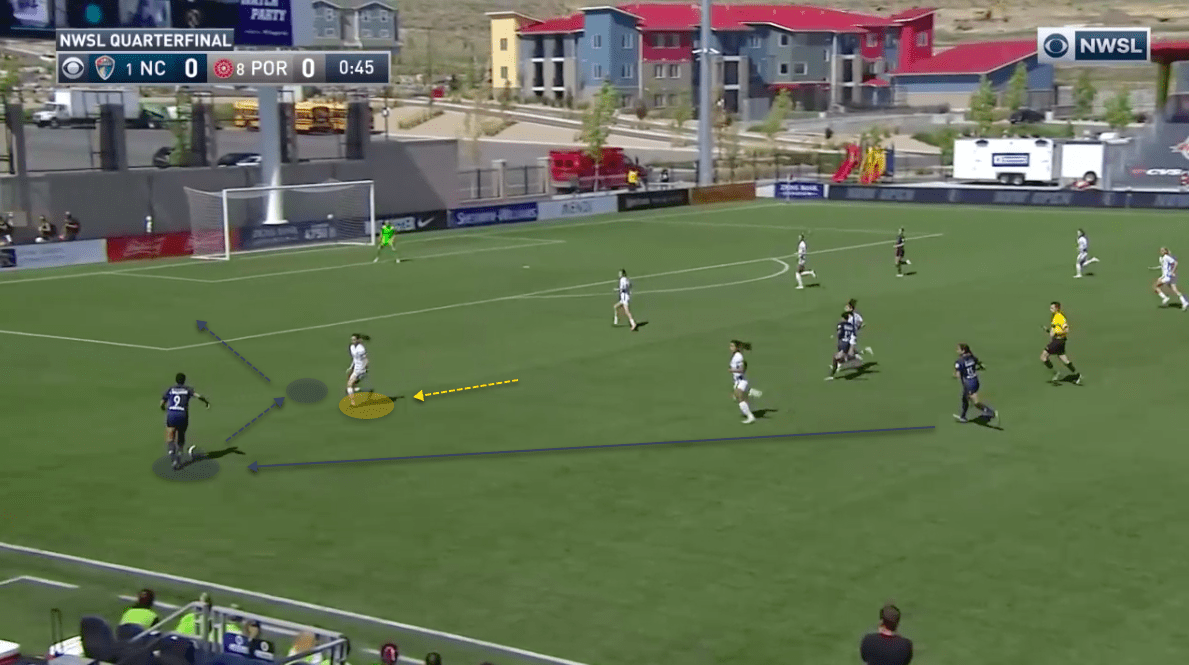
Williams uses her speed to beat the full-back into this wide channel and as she receives the pass from Hinkle, Reynolds is still working to recover her position. Williams drives directly towards the retreating full-back and waits for her to take a step into her direction before bursting down the line and into the penalty area to get a shot in that narrowly missed the target.
Portland’s forwards
While respecting North Carolina’s attacking ability, Portland worked numerous chances of their own throughout this match. The favourites came out with an xG of 2.97 in the game, but Portland compared fairly similarly, producing an xG of 2.25. In this section, we will look at the main tactics behind Portland’s attacking movements that allowed them to craft their opportunities.
Using the 4-3-1-2, their most effective attacking avenue came down the middle of the pitch. Only nine of Portland’s 37 positional attacks were made through the middle, but these moves produced 1.18 xG, in comparison to the 1.04 xG from attacks down the right and left channel combined.
Morgan Weaver was essential in these tactics working effectively. While she lined up as part of a front two, she was often found dropping deep to provide an outlet to her teammates deeper on the pitch. As you can see in the position map below, Weaver (22) provided the link between the four midfielders and Lussi (34) up top.
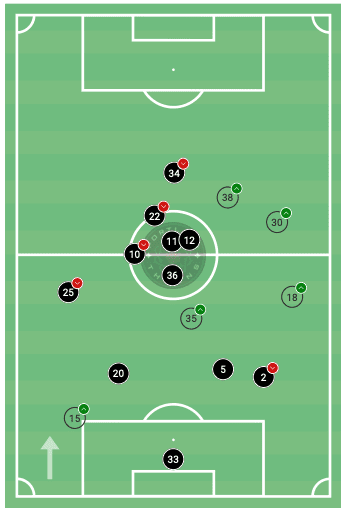
This tactic was crucial in Portland’s efforts to progress play and relieve pressure on their defence. Weaver’s presence in the just behind the North Carolina midfield allowed the side to create numerical advantages in this area of the pitch. Once possession was moved into her here, one of either the advanced midfielder or the wide central midfielders would push forward and move into the space vacated by the centre-forward up front and look to expose this space.
The movement of the strikers would prove to be a constant theme throughout the match and had a big part to play in the only goal of the game. In the build-up to Portland’s goal, possession was worked down the right channel. Recognising the need for support, Lussi moved into the channel herself to link up with her right-back Westphal.
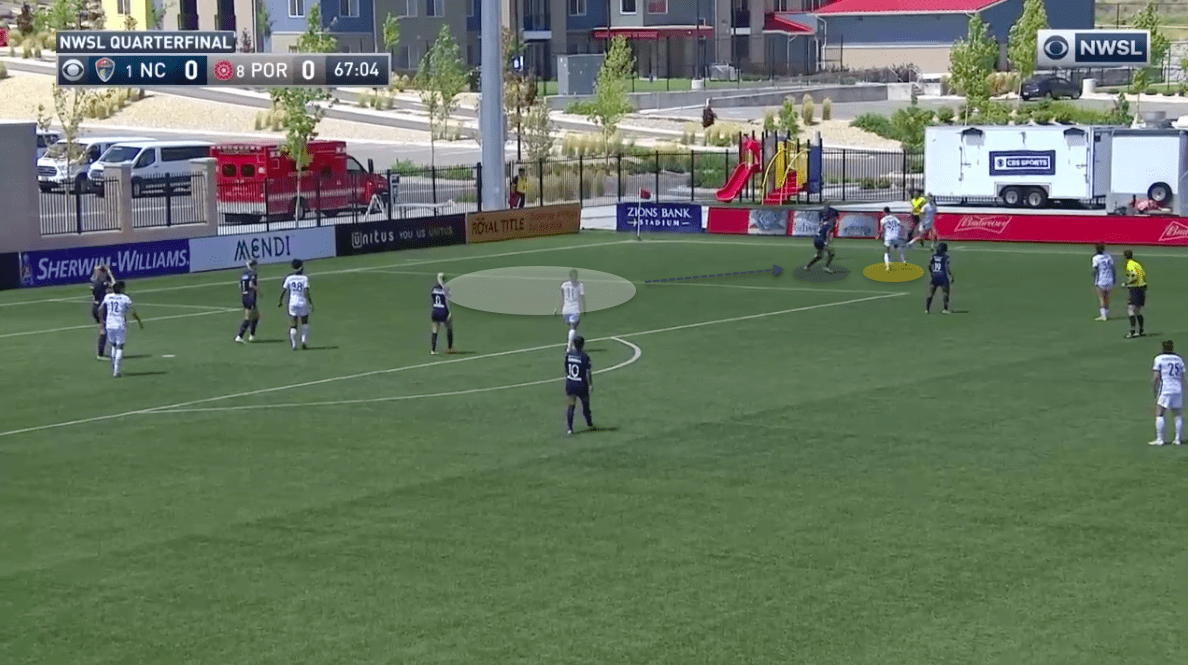
Her movement into this area dragged the North Carolina centre-back out of her position as well. In the image above you are able to see this movement and the effects it has on the North Carolina defence. This opened up a huge gap through the half-space that was exploited by a midfield runner. The Courage midfielders are late to react and cover this space and the attacker is able to move into this space and deliver a cross to Weaver who arrives perfectly in the six-yard box to tap in the game’s only goal.
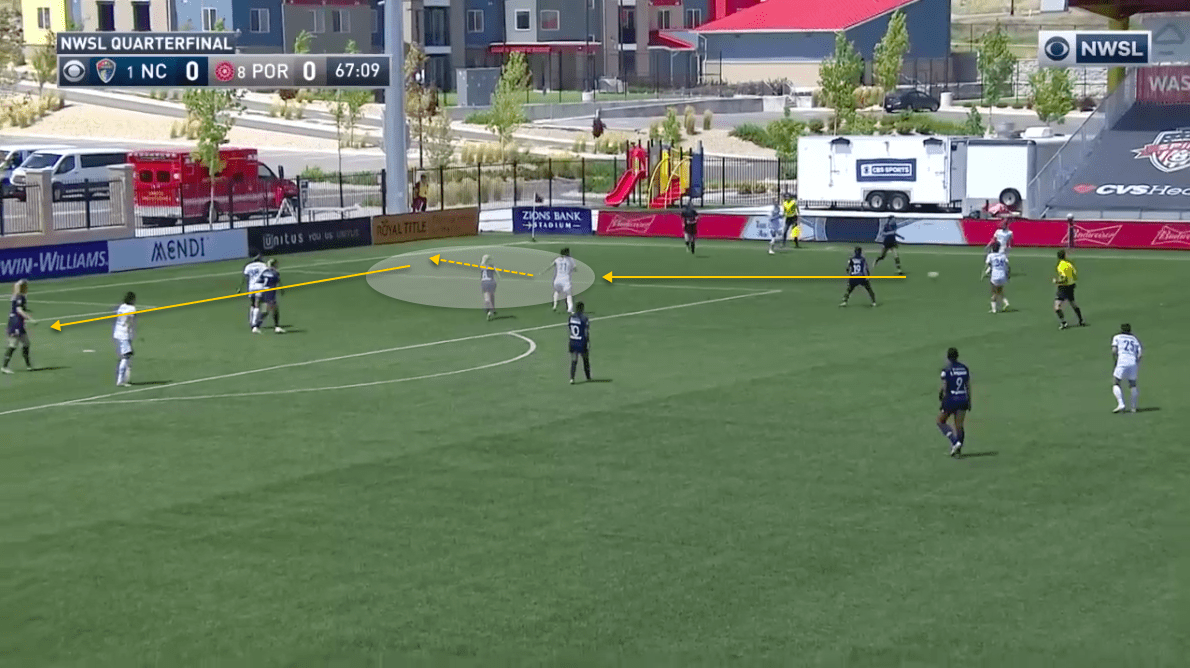
Portland’s restrictive defensive structure
One of the primary advantages of Portland’s structure came in their defensive half. North Carolina’s 4-2-2-2 is so effective in large part to their advanced midfielders. Debinha and Dunn’s creativity and ability to find space make containing the reigning champions an almost impossible task.
In their attempts to do this, Portland aimed to restrict the middle of the pitch using their narrow formation. This way, the space Debinha and Dunn were able to find in between the lines in dangerous areas was limited, and instead, they were forced into moving wide to try and receive possession and build attacks. While they can be dangerous from these areas as well, Portland stood a much better chance of containing them out here. This tactic can be seen in the position map shown in the previous section.
This defensive structure had a massive effect on North Carolina’s tactics. Below you are able to see the team’s dribble attempts throughout the first and second half of the match. Notice in both of the maps, there is a lack of successful dribble attempts in the middle third of the pitch. This is directly due to Portland’s midfield set up limiting this space.
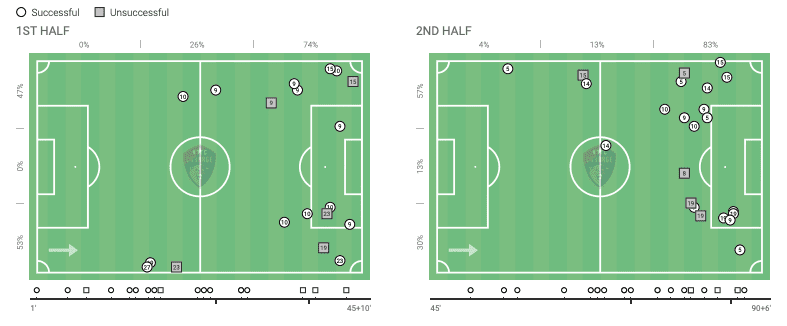
Because of this, North Carolina were forced to move their creative players wide to receive possession, and from there, often settled with a cross. The Courage attempted 39 crosses in this quarterfinal match, completing 10 (25.4%) of them. Over the last calendar year, Paul Riley’s side have averaged 26.58 crosses per 90.
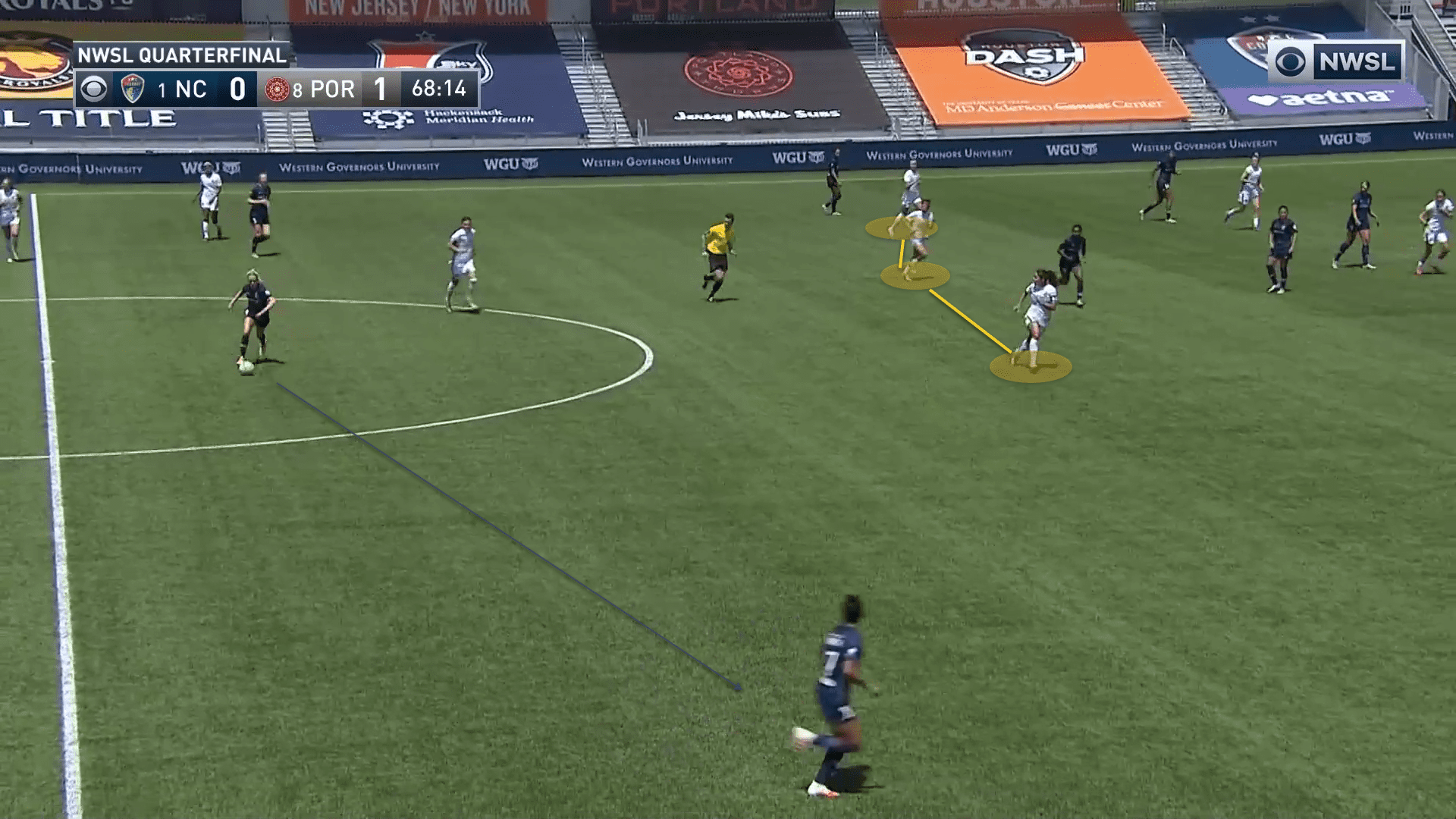
In the image above you can see North Carolina looking to begin an attack into the Portland half. As the player in possession assesses her options, Portland’s midfield makes a block restricting any penetrative central passes. They encourage the pass out wide into Merrick.
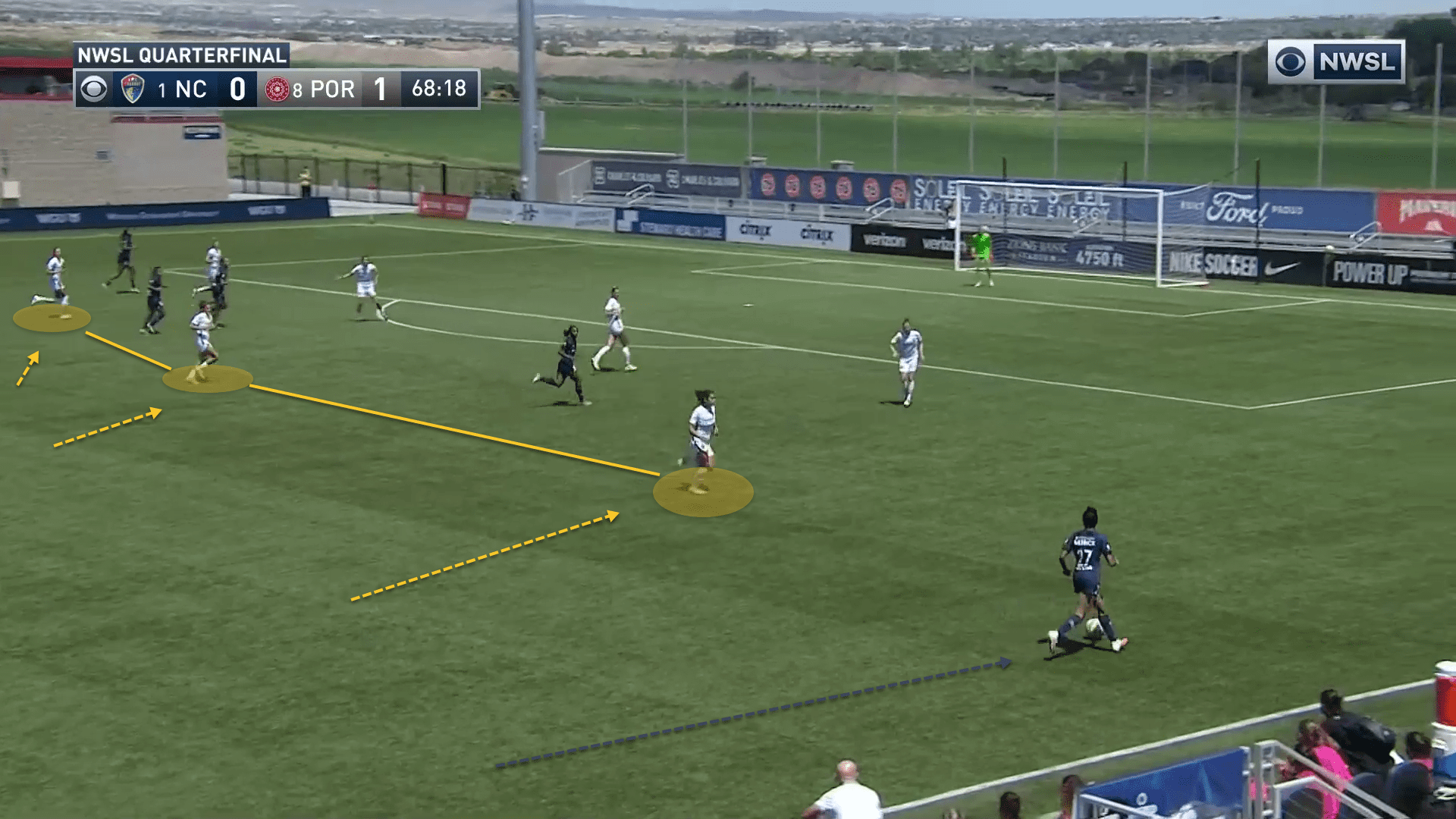
Once this pass is made and the full-back advances into the final-third, Portland’s deep midfield line restricts to block space in the middle of the field once more. Notice the limited space that is given to the likes of Dunn and Debinha, who have no room to present any central options to their teammate. The result of the attack is a cross which is dealt with easily by the Thorns defence.
Conclusion
While this might not have been the result many would have anticipated heading into this match, Portland were worthy of the result. With help from their backup goalkeeper Eckerstrom, who produced a magnificent display to protect her clean sheet, Portland executed their tactics very efficiently.
This analysis has highlighted the key points from both sides in this match. Portland will need to continue their efforts in this same vein as they match up against the Houston Dash in the semifinals of the NWSL Challenge Cup on Wednesday the 22nd. For all of the disappointing results to this point, however, they will move into this match with their confidence very high.






Comments